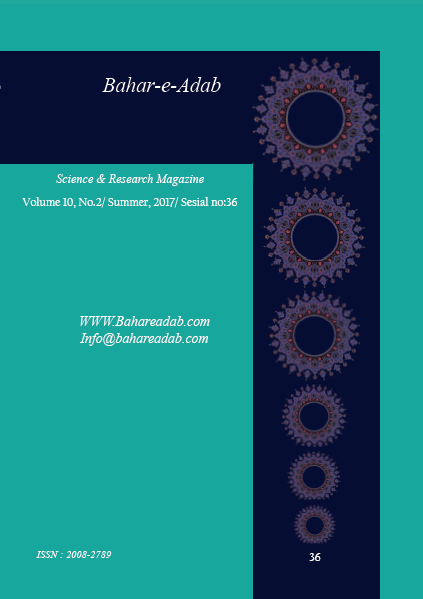- Count View : 493
- آدرس کوتاه شده مقاله: https://bahareadab.com/article_id/55
volume Number 10،
number In Volume 2،
،
issue Number 36
Style and Rhetoric of Attar in prayer
farideh Davoudi Moghaddam(Author in Charge)
Abstract
Prayer as a form of religious behavior is intended to seek contact with the existence of the eternal that the individual worshiper bounces him as his creator or spiritual being into consideration.Worshipping is performed in different ways in various religions.
Since the old days the ways of praying and worshiping among people as one of the most important elements of religious teachings have been of great interest to researchers.
Attar is a prominent Sufi poet and genius of the Persian language who takes advantage of prayer to express his moral and spiritual lessons. He offers many of his sublime lessons in these prayers and teaches his audience directly and indirectly and visualizes many humans’ inabilities and perplexities on Earth and praying God, in the light of hope.
He speaks of life and spiritual life and death that can offer solutions for the problems of human or to conform him or offer him sympathy and help.In some cases, the prayers criticize most of the problems, disorders, and power relations of the society. This study investigates some of Attar’s prayers and their features in his couplet-poems
Keyword
Prayer
, Attar
, couplet-poems
- Attar Neyshabouri, Farid al-Din (2007) Asrarnameh, edited by Shafiee Kadkani, Tehran: Sokhan
- .......... (2008) Elahi Nameh, edited by Shafiee Kadkani, Tehran: Sokhan
- ............ (2007), Misyabnameh, corrected by Shafiee Kadkani, Tehran: Sokhan
- Klini Razi, Abi Jafar Mohammad Ibn Yaqub Ibn Ishaq (1375), translated by Javad Mostafavi, Tehran: Vali Asr
- Ibn Athir, Izz al-Din (1370) Al-Kamil Fi Al-Tarikh, translated by Mohammad Hossein Rouhani, Tehran: Asatir
- Underhill, The First (2006) Spiritual Life, translated by Simin Saleh, Tehran: Shoor
- Nejati Hosseini, Seyed Mahmoud (2013), Analysis of Prayer Literature, Journal of Social Studies and Research in Iran, Volume 2No1p37
- Anousheh, Hassan (2002) Encyclopedia of Persian Literature, Tehran: Tab ve Nashr
- Forouzanfar, Badi-ol-Zaman (1995) Biography and Critique and Analysis of Sheikh Farid al-Din
- Salimi, H. (2010) The Application of Allegory in Cognitive Reconstruction, Quarterly Journal of Education Growth, Volume 5, Number 4, Page 46
- Dehkhoda, Ali Akbar (2003) Dictionary, Tehran: University of Tehran
- Hailer, Friedrich (2013) Prayer, translated by Shahabuddin Abbasi, Tehran: Ney
- Shariati, Ali (1370), Niayesh, Tehran: Elham

